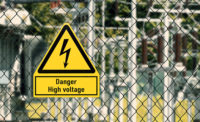Isolating hazardous energy with maintenance procedures
Lockout-tagout devices must resist corrosives, wet environments, improper removal

When employees perform maintenance on machinery or equipment, you must ensure that they know how to protect themselves from the release of hazardous energy. OSHA’s control of hazardous energy (lockout/tagout) standard at 1910.147 requires you to create procedures for employee protection.
Your primary tool for providing protection is the energy isolating device — a mechanical device (like a circuit breaker or disconnect switch) that physically prevents the transmission or release of hazardous energy. A simple on/off switch might turn off the power, but it does not isolate the equipment from the energy source.
There are two categories of energy isolating devices: those capable of being locked out and those that are not.
When the system is capable of being locked out, the lock holds the energy isolating device in a safe position. OSHA does allow tags instead of locks, if you demonstrate that the tagout program protects employees as much as a lockout program.
If the energy isolating device is not capable of being locked out, you must have procedures for applying a prominent warning (tagout) device. The tag alerts employees to the hazard of re-energization and warns employees not to operate the machinery until the tag is removed according to your established procedures. Generally, tags provide less protection than locks against improper removal.
Locks or tags used to control hazardous energy must be provided by the employer and may not be used for any other purpose (e.g., to lock a toolbox). The locks or tags must also be:
- Durable,
- Standardized, and
- Substantial.
Durable
Locks and tags must stand up to workplace conditions. Locks should be durable in most environments and must indicate the identity of the employee who applied them. If the name isn’t legible, that requirement hasn’t been met.
Similarly, tagout devices must not deteriorate or become illegible, even when used in conjunction with corrosive components such as acid or alkali chemicals, or in wet environments.
Standardized
Locks and tags must have a standardized color, shape, size, or a combination of these. In addition, tags must be:
- Standardized according to print and format;
- Legible and understandable by all employees;
- Marked to warn against hazardous conditions if the machine is energized and offer employees clear instruction such as: “Do Not Start,” “Do Not Open,” “Do Not Close,” “Do Not Energize,” or “Do Not Operate.”
Substantial
Make sure your locks and tags actually minimize the risk early or accidental removal. An employee without the key or combination should not be able to remove locks without using special tools such as bolt cutters or other metal-cutting tools.
Lockout devices must be substantial enough to prevent removal without the use of unusual techniques. For example, nylon cable ties are not substantial devices because they could be removed using common cutting tools (e.g., pocket knives or scissors) or by releasing the pawl with a screwdriver.
Tags must be non-reusable, self-locking, and non-releasable, with a minimum unlocking strength of 50 pounds. The tag should be attached using a one-piece nylon cable tie or its equivalent that can withstand all environments and conditions.
Labeled
As noted, locks and tags must identify the employees who apply them and are authorized to remove them. The authorized employee identified knows that only he will be allowed to remove the device(s).
This user identification also provides additional accountability. It enables the employer to inspect the application of energy control procedures and determine whether employees are properly implementing the procedure. If locks and tags are not properly attached, for example, the employer can locate the non-complying employee and correct the problem promptly.
Removal
The purpose of sturdy locking and tagging devices is to protect employees during maintenance by preventing unauthorized removal. Those devices should be removed only by the authorized employee who applied them – but sometimes that person isn’t available. Sometimes, that will mean cutting the lock.
However, OSHA allows employers to establish procedures for removing locks other than by destruction. For example, employers may have a master key – but only if the employer also develops, documents, and implements specific procedures to ensure employee safety when someone else removes the lock.
In the end, safety does not come from locks and tags — it comes from procedures, training, and accountability.
Looking for a reprint of this article?
From high-res PDFs to custom plaques, order your copy today!





